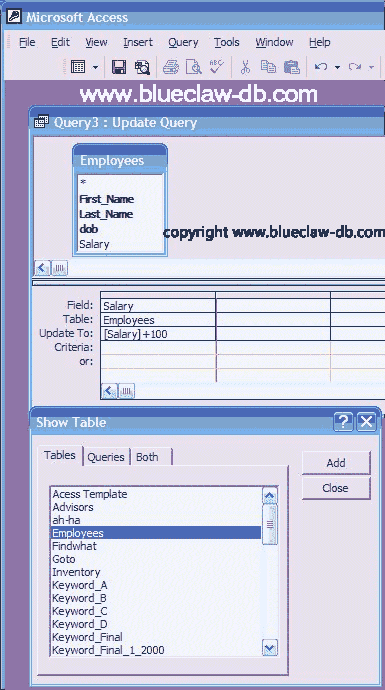
Now only blank values in that field will be updated.įigure 2 shows the modified query in Design view. Now we only want to change the new records, so enter Is Null in the DateOrder’s criteria. The first time we ran this query, all the DateOrder fields needed to be filled.
Microsoft access update query update#
Since this data is for February, change the Update To expression under DateOrder to DateSerial(2018,2,). Open qUp_Import_DateOrder in Design view. Like with the January data, the OrderDate needs to be updated for the newly imported data. Open importOrders to verify that the February data has been added. We don’t want to, so leave it unchecked and then click Close. A new dialog will ask if you want to save the import steps. The last dialog box will have a field indicating the data should be imported to the importOrders table. The next dialog will show a preview of the data and a checkbox for “First Row Contains Column Headings.” It should already be selected, so click Next. Choose the “Feb” worksheet and click Next. The next dialog box displays the list of worksheets available to import. In the wizard dialog, choose “Append a copy of the records to the table” and then select the importOrders table from the drop-down. Browse to the file you want to import, EXCEL_Orders_2018_Colored.xlsx, and click Open.

(If that isn’t visible on the ribbon, you may need to click on the New Data Source drop-down button and select From File, Excel.) This launches the Get External Data wizard. In the Import & Link group on the External Data tab, choose Excel. Now we’ll import the next sheet in the Excel workbook. Open the importOrders table to verify that the data has been updated. A message will appear asking if you want to update 6 rows. Save the query as “qUp_Import_DateOrder.” Run it. In the Update To row for DateOrder, add the expression we just verified: DateSerial(2018,1,). In the Query Type group on the Design tab, select Update. Switch to Datasheet view to verify that the calculated date is correct (see Figure 1). We know the data came from January 2018, so those arguments are coded directly into the function, and the Dy field is used to get the specific day.

CalcDate is the new field name, and the DateSerial function creates a date when given a numeric year, month, and day. In the second column of the grid, enter CalcDate: DateSerial(2018,1,) to create a calculated field. Type in the new name and press Enter.Ĭreate a new query based on the importOrders table. Since we will eventually append more months to this table, rename the table to “importOrders.” To do this, right-click on the name in the navigation pane and choose Rename from the shortcut menu. Add a field called “DateOrder” with a data type of Date/Time. The original worksheet only included a column (Dy) indicating on which day of the month an order was placed.

Last month, we imported the first month of data from an Excel workbook into a table called “importJan.” Before importing additional months from the Excel workbook, we need to update the January records so they have an actual order date.


 0 kommentar(er)
0 kommentar(er)
